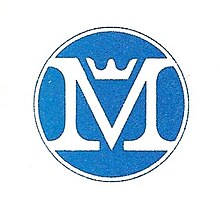Malleable Iron Range Company
 |
|
| Industry | Household Appliances |
|---|---|
| Founded | 1896 |
| Founder | Silas McClure A.C. Terrell |
| Defunct | 1985 |
| Headquarters | St Louis, Missouri Beaver Dam, Wisconsin |
|
Key people
|
|
| Products | kitchen ranges, refrigerators, stoves |
Malleable Iron Range Company was a company that existed from 1896 to 1985 and primarily produced kitchen ranges made of malleable iron, but also produced a variety of other related products. The company's primary trademark was Monarch and was colloquially often referred to as the Monarch Company or just Monarch.
The Malleable Iron Range Company was founded in St. Louis, Missouri, in 1896 by Silas McClure and A.C. Terrell. The company was incorporated in 1899 with Monarch as a trademark.
In 1900 the Dauntless Stove Manufacturing Company of Omaha, Nebraska, became indebted to the Beaver Dam Malleable Iron Works for $5000, for castings ordered by Dauntless from the Iron Works. Consequently, all the machinery and equipment of Dauntless was moved to Beaver Dam. In January, 1901 a new company was organized in Beaver Dam under the name Dauntless Manufacturing Company.
In July 1901, McClure and Terrel of the Malleable Iron Range Company of St. Louis, negotiated an agreement under which they became associated with Dauntless, subsequently moving their business to Beaver Dam. In February 1902, the name of the Dauntless Manufacturing Company was changed to the Malleable Iron Range Company. In 1902, the company had about 20 employees. The average price of their ranges was about $60 which was about twice the selling price of the typical range of the time. Despite the high price, the ranges sold well as they were recognized as being a much better quality and easier to use than the typical range sold at the time.
At the Lewis and Clark Centennial Exposition in Portland, Oregon in 1905, the Monarch was awarded the highest prize, the World's Fair Gold Medal, and it also received single recognition by the Jury. At the Alaska-Yukon-Pacific Exposition in Seattle, Washington in 1909, the Monarch was awarded the gold medal.
Prior to 1910, the malleable iron castings needed for their products were purchased from other companies until they could build their own foundry. Additions to the manufacturing building and annealing building were also built in 1910. In 1912 a warehouse was constructed which was later used as a machine shop. In 1914 a steel room was built and in 1916 an oxidizing building and additional casting and storage buildings were constructed.
Despite the appearance that Malleable was poised for long term successes, this was not guaranteed. There were many stove manufactures that would not survive the coming decades. The 1918 Engineering Directory has eight pages listing approximately 400 manufactures of stoves in the US.
After the World War, building construction projects resumed. In 1920, additions to the enameling building and a new foundry were built. In 1925 and 1926 a warehouse, and sections joining existing buildings, were constructed. By 1928 additions on the south end of the property provided more space for manufacturing electric ranges as well as warehouse, office, and storage space. An experimental and teaching kitchen was included in this addition. By 1929 the plant consisted of 26 individual departments and more than 400,000 square feet of floor space. The plant was producing more than 300 various styles and models of four types of cooking devices: coal/wood, electric, gas and combinations of any two of those types. In addition to domestic equipment, commercial ranges were produced for restaurants, hotels and other institutions.
...
Wikipedia
